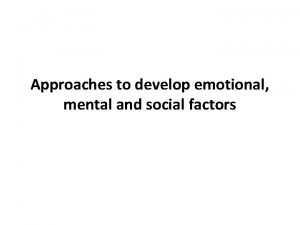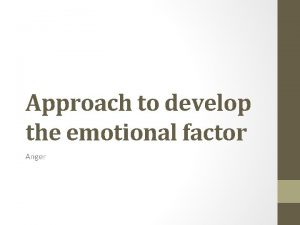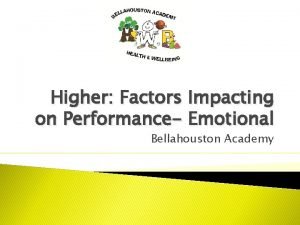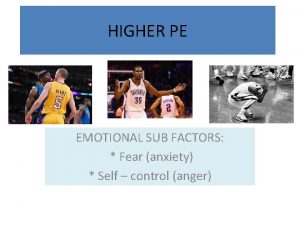Higher PE Emotional Factors Emotional Factors The main














- Slides: 14

Higher PE Emotional Factors

Emotional Factors The main emotional factors that impact on performance are; Happiness/Sadness Anger Fear

Happiness/Sadness Is an emotional state of mind. Ranging from feeling content and joy (happy) to a feeling of despair, grief or sorrow (sad). Happiness and sadness can impact on numerous factors such as confidence, self-belief in your own ability, resilience, and your ability to realise your potential. For example, being in a happy state of mind before playing basketball will increase your confidence in executing skills and your self-belief in performing them successfully. If you were sad before playing a game of football, your confidence and belief in your ability to perform skills successfully will be low resulting in a poorer level of skill execution

Anger An emotion whereby the individual has normally been offended, denied, wronged and a tendency to react through retaliation. It is a strong, uncomfortable emotion after being provoked. Anger in sport can be very useful in the right situation but more often than not it is about how you control your aggression that makes the difference. Opponents look to ways of irritating each other in the hope it puts them off a game plan or affects their performance.

Anger In Dance, Anger may be conveyed as an emotion in your routine. Movements will be fast, precise and aggressive in nature. You must have control of that feeling of anger to make the movements effective towards your routine. However if you lose that control you may lose the precise movements or timing that is important to achieve a high mark/grade.

Fear is an emotion induced by a perceived threat, which causes you to quickly pull away or, in sporting terms, usually hide. Fear produces negative thoughts, which directly impact on a sportspersons confidence. Confidence has a direct response to performance. If you fear an opponent or opposition then it is likely that your own performance level will drop significantly which will make it easier for opposition to compete.

Gathering Information on Emotions Gathering information can be characterised in terms of Quantitative and Qualitative Data. Quantitative data is concerned with facts and figures and provides statistics and a measurement of performance in related areas.

Gathering Information on Emotions Qualitative methods are ways of collecting data which are concerned with describing meaning, rather than with drawing statistical inferences. Methods include interviews and receiving feedback from a coach or teacher.

Gathering Information on Emotions An example of this Qualitative Data would be for a performer to complete an Emotional Questionnaire which gathers information on the emotional state of the performer prior to beginning a skill development programme or prior to competition. (Sport Emotion Questionnaire)

Sport Emotion Questionnaire Completed 1 hour prior to performance Completed in a quiet space away from distractions Results are kept and referred to later on

Question Choose an activity Analyse the method you used to gather information on the Emotional factors that impacted on your performance within this activity (4 marks)

Question 1) Set the scene (activity / factor / method) 2) Explain what you did 3) Why was this method appropriate (this is where you get your marks)

Benefits of Questionnaire Consistent set questions make it reliable and accurate (the data is clear and cannot be misinterpreted) Easy and quick to use It is a recognised test which increases the validity Comparison against the norms online and in class You can compare your results over the course of a training programme (improvement) No equipment required

Limitations of Questionnaire Performer must be honest with their results for the data to be accurate If the performer is demotivated they will not complete the test as accurately as a motivated performer (results skewed) Must understand the data to make appropriate conclusions and next steps
 Emotional factors higher pe
Emotional factors higher pe Emotional sub factors pe
Emotional sub factors pe Sports emotional questionnaire higher pe
Sports emotional questionnaire higher pe External factors higher business
External factors higher business Higher business decision making
Higher business decision making Mental factors pe
Mental factors pe Approaches to develop emotional factors
Approaches to develop emotional factors Approaches to develop emotional factors
Approaches to develop emotional factors The future will
The future will Stated main idea
Stated main idea Void main int main
Void main int main Hình ảnh bộ gõ cơ thể búng tay
Hình ảnh bộ gõ cơ thể búng tay Lp html
Lp html Bổ thể
Bổ thể Tỉ lệ cơ thể trẻ em
Tỉ lệ cơ thể trẻ em

























